How to adapt your triathlon training around menstruation for better performance
 Karen Parnell
May 29, 2022
Karen Parnell
May 29, 2022
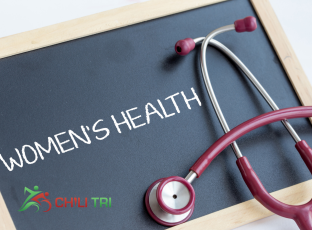
How to adapt your triathlon training around menstruation for better performance
There have been various recent studies around how hormones and how you feel impacts your training at different stages of your menstrual cycle. This article will discuss the findings and how this can help you train more effectively. It will be interesting to see if these align with how you feel during the month and how it affects your training.
A growing body of evidence suggests that when female athletes adjust their training to fit with their menstrual cycles, they perform better.
Menstruation Phases
The first step is to understand the menstruation phases or refresh our knowledge of them.
A typical cycle lasts for between 28 and 35 days and for some women the pattern is predictable; others, not so and this is another reason to understand what is normal for you as an individual. The cycle can be broken down into two main phases:
The follicular phase (typically days one to 14): Day one starts with menstruation. Oestrogen levels are low on day one and slowly increase to day 14; at the same time, progesterone levels are low.
Ovulation happens at around day 14 (depending on cycle length), ovulation occurs, and an egg is released. At this time, oestrogen levels peak and progesterone levels increase.
The luteal phase (typically days 15 to 28) is the hormone phase when progesterone is higher. Basal body temperature increases, too, so you may feel slightly warmer. Should an egg not be fertilised, both hormones then begin to fall, and the next phase begins again with menstruation.
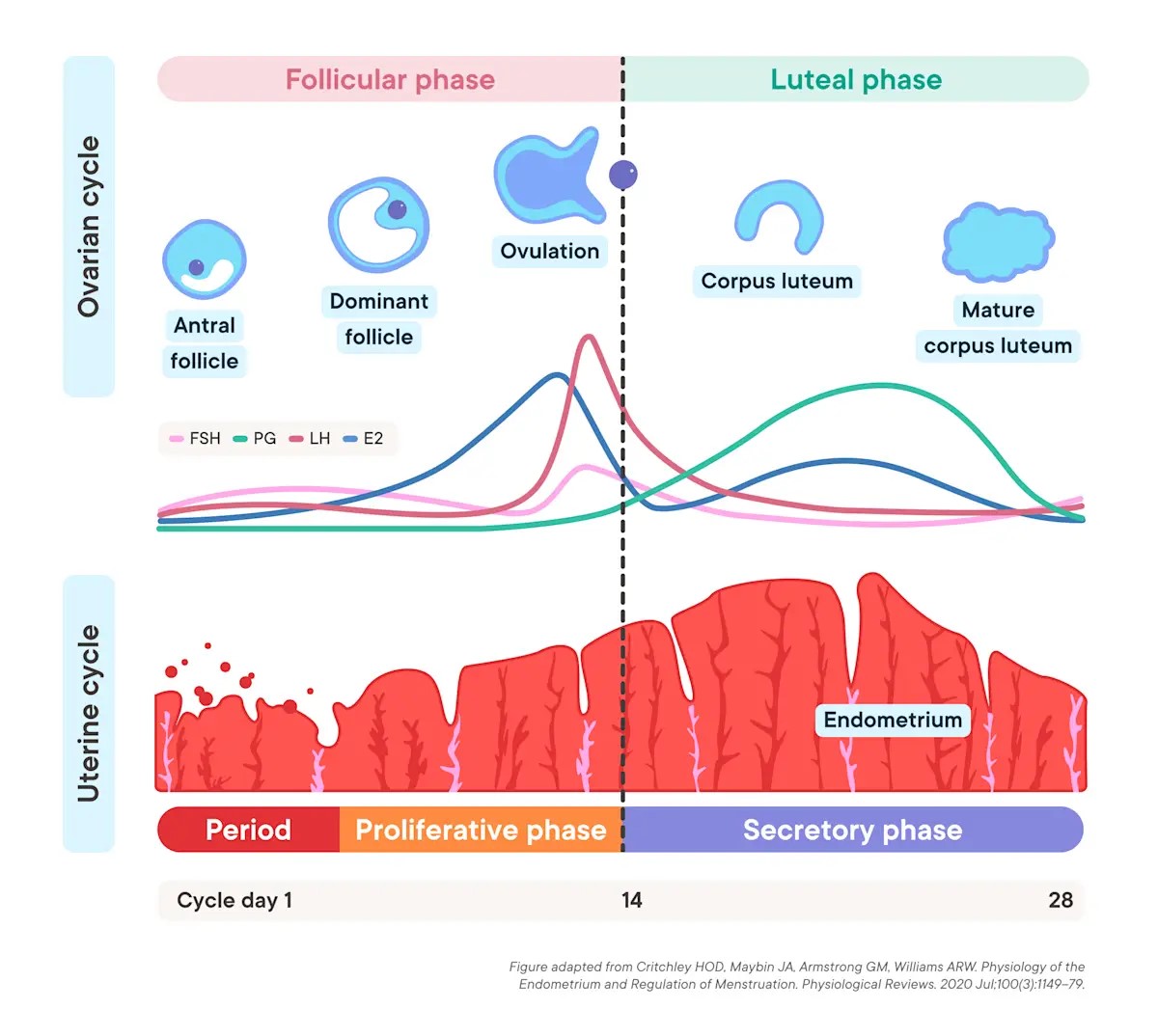
Menstruation Phases and Training
Follicular Phase: Progesterone and oestrogen levels will be at their lowest during the start of your cycle and can cause low energy and mood fluctuations. However, it’s been proven that the body adapts and responds much better to strength training at this stage of your cycle compared to the latter stages. Therefore, this can be a good time to incorporate strength exercises, such as weight training, into your routine.
Ovulation: There’s a surge in oestrogen and testosterone levels around the time of ovulation – which usually starts around day 14. The change in hormone levels at the stage can be a good time to implement higher training intensity and volume into your exercise regime.
Luteal Phase: The final 14 days of the cycle sees progesterone levels rising, which can lower your mood. By exercising at a lower intensity during this time, women can boost serotonin and endorphin levels to alleviate these symptoms.
Basal Metabolic Rate (BMR)
When it comes to adapting your diet to align with your menstrual cycle, it’s very individualised. However, as always keeping a balanced diet while matching calorie intake to exercise volume and intensity will ensure you’re feeling energised throughout your cycle.
Here´s a great medically reviewed article the Healthline on food to eat and avoid during your period.
A first step to improved performance is to ensure that you have enough calorie intake to train effectively. If you don´t know your Basal Metabolic Rate (BMR) already then it´s worth calculating this. Here's a link to the ChiliTri BMR calculator.
So, what is BMR? Even when resting, your body burns calories by performing basic functions to sustain life, such as:
- breathing
- circulation
- nutrient processing
- cell production
Basal metabolic rate (BMR) is the number of calories your body needs to accomplish its most basic (basal) life-sustaining functions.
We must meet these calorific minimums in order to maintain healthy bodily functions before we even consider the needs for endurance training. The number you use to calculate your BMR will change based on how active your job and daily lifestyle are. If you sit at a desk all day your number will be lower than someone who is standing and moving all day such as a delivery driver or a surgeon who is in the OR for 4-6 hours a day. This can have a huge impact especially as training volume, intensity or life stress goes up.
So, on top of a healthy, balanced diet it´s worth calculating your BMR to ensure you are eating enough on a daily basis and not falling into a state of Low Energy Availability (LEA) or even worse Relative Energy Deficiency in Sport (RED-S). I will cover these topics in the next article.
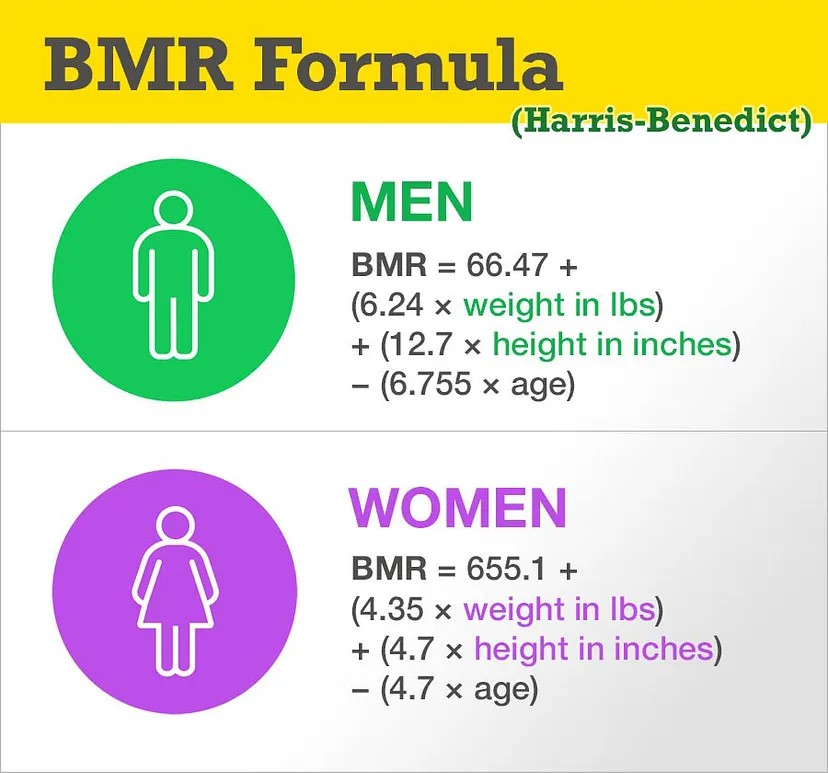
Nutrition and your Menstruation Phases
Once you start to see patterns emerge from the app that you choose, you can start to train and eat according to the phase that you’re in.
The follicular phase
Ironwoman – At this phase, your body is craving iron. Familiar sources like red meat, dark chicken meat and shellfish should be on the menu. However, don’t forget that whole grains and legumes like beans, peas, chickpeas, lentils and soybeans can also deliver the iron you need.
Omega 3 – In addition, eating foods high in omega-3 fatty acids will help fight increased inflammation. Think salmon, mackerel, tuna, herring and sardines, along with nuts, seeds and plant oils. As with iron, you can use supplements to get what you need, but getting these nutrients from food is best.
H2O – Your body has an excellent handle on staying cool and hydrated during this phase. Definitely make sure you’re getting enough water, but don’t make it a massive priority.
The luteal phase
Think Carbs – This is when you need to get your fuel from carbohydrates both before and during workouts.
Listen to your body – During these weeks, you will probably feel hungrier than usual. This is completely normal. In fact, your body uses up 5-10% more calories during this premenstrual phase. Don’t fight it and listen when your body is telling you to eat.
More H2O – It can be more difficult to stay hydrated during the luteal phase, so keep water at hand, especially during and after workouts.
Tracking your Nutrition and Hydration
As you can see your hydration and nutrition can have an impact not only on your ability to train effectively but also can impact your cycle and symptoms. Tracking your hydration and nutrition should be a thing to consider maximising your training success.
You can track this using apps like Myfitnesspal or Eat 2 Win.
If you want to collect more data on how your body handles different carbohydrate-based food or drink and how it effects your training and racing, then the Supersapians biosensor and App will give you the answers.
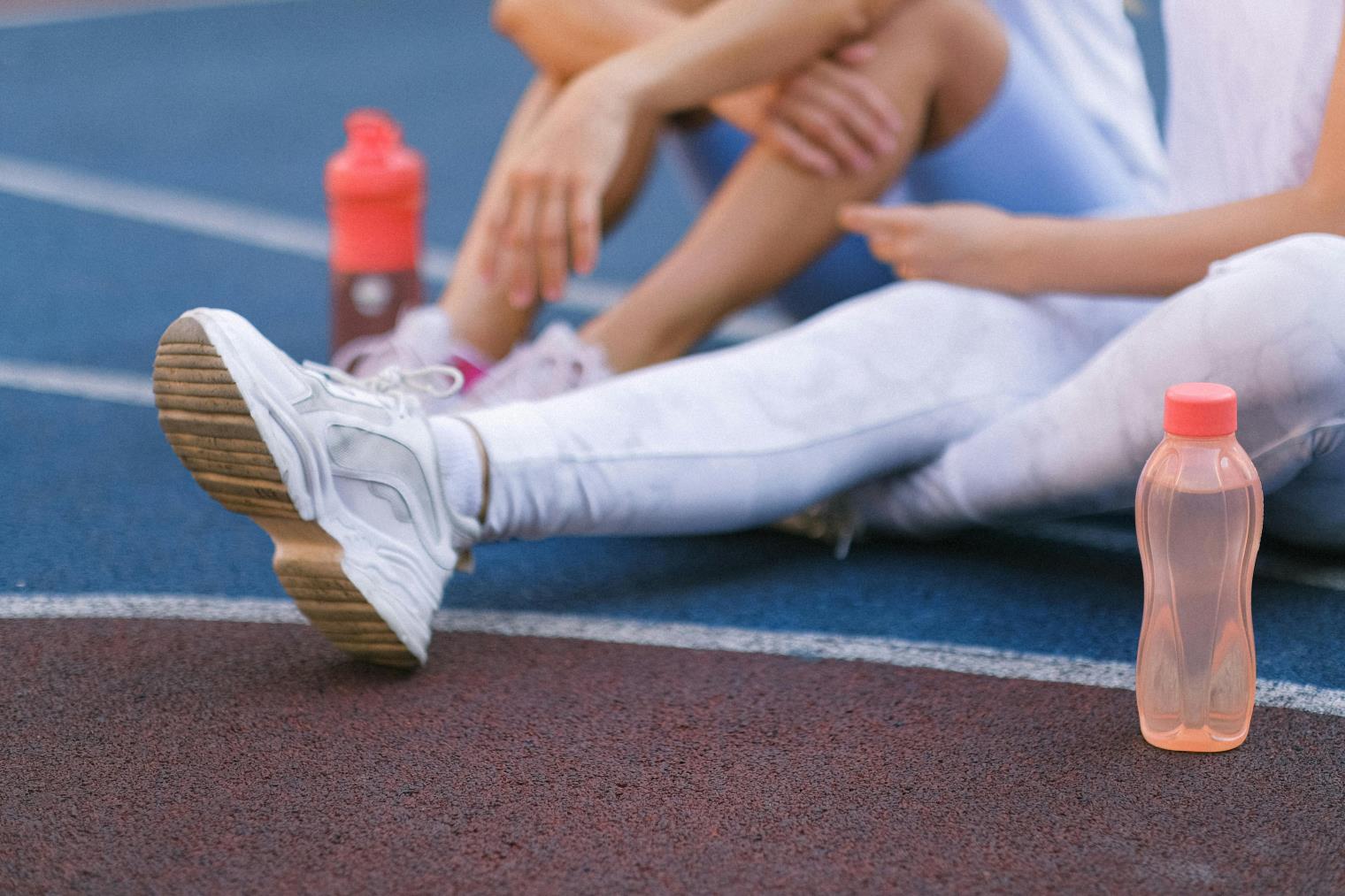
Tracking your Menstrual Cycle
You can easily track your cycle dates using the Garmin Connect App and as an athlete having all data in one place may be a good idea.
There are other Apps like Clue and MyFlo but as with all Apps they are only a good as the data you input such as days, symptoms, diet and weight.
There is also a tracker band that you could wear called Ava, but this is more for fertility tracking rather than for athletic performance.
The company Athlete Monitoring offer a menstrual cycle tracker as part of their wellness and readiness package. This is more for teams and coaches so not ideal for most athletes, but the idea is a step in the right direction.
It is designed to help coaches plan light or heavy workloads according to each athlete’s individual cycle in order to maximize performance while minimizing the risk of injury. It also detects and flags irregular cycles and potential medical issues, offering proactive recommendations for users and coaches.
There is a company called Fitrwomen which helps you track your menstrual cycle and provides personalized training and nutritional suggestions tailored to the changing hormone levels throughout your cycle and syncs with Strava.
Jessica Ennis Hill, gold medalist at heptathlon, has just launched an App to track your cycle and learn when it's best to train and how. The App helps you map different fitness sessions to the four phases of your menstrual cycle so that you get fitter and stronger, feel more energised, reduce hormone imbalances, build lean muscle and much more.The new App is called Jennis and you can download it here.
There are companies developing wearable sensors to measure hormone levels and I expect to see them emerging commercially in the next few years.
![]()
Mood and Menstruation
Hormonal fluctuations during your menstrual cycle can have a positive impact on your energy levels and performance. The release of endorphin and serotonin associated with exercise has an antidepressant and mood-elevating effect, which can also help women through symptoms related to the menstrual cycle, such as a low mood. In addition to this, these hormones can also help alleviate cramps and bloating, which is associated with the menstrual cycle.
Conclusion: Training and Menstruation
Whatever method you choose to track your menstrual cycle, even if its pen and paper, it´s worth doing so you can understand your personal situation and how it affects your mood and training capacity and effectiveness. This can be used alongside tracking your nutrition and hydration to develop a picture of when in your menstrual cycle you can train harder (high intensity sessions) or focus on more endurance-based sessions.
Training needs to be personalised in order to be effective. If your hormone levels make you feel less able to train or period symptoms impact your ability to train, then these need to be factored into your training plan.
Would you like a free training plan? Claim your free plan or e-book.
Get a menopause recipe book here.
Summary of Training and Nutrition
| Menstruation Phase | Rationale | Nutrition | Training Type |
|---|---|---|---|
| The follicular phase (typically days one to 14) | Progesterone and oestrogen levels will be at their lowest but it´s been found the body adapts well to strength training | Iron, Omega 3 and Water | Strength Training |
| Ovulation (around day 14) | Surge in oestrogen and testosterone levels | Protein, Fibre and antioxidants like raspberries and strawberries | Higher training intensity and volume |
| The luteal phase (typically days 15 to 28) | Progesterone levels rising, which can lower your mood. By exercising at a lower intensity during this time, women can boost serotonin and endorphin levels to alleviate these symptoms | You will feel hungrier and need Carbs and more water | Lower intensity training |
Karen Parnell is a Level 3 British Triathlon and IRONMAN Certified Coach, 8020 Endurance Certified Coach, WOWSA Level 3 open water swimming coach and NASM Personal Trainer and Sports Technology Writer.
Karen has a post graduate MSc in Sports Performance Coaching from the University of Stirling.
Need a training plan? I have plans on TrainingPeaks and FinalSurge:
I also coach a very small number of athletes one to one for all triathlon and multi-sport distances, open water swimming events and running races, email me for details and availability. Karen.parnell@chilitri.com
Get your FREE Guide to Running Speed and Technique
Get your FREE Swim Workouts for Triathletes E-book
Get your FREE Open Water Swimming Sessions E-Book
References and Studies
The Impact of Menstrual Cycle Phase on Athletes’ Performance: A Narrative Review
https://www.mdpi.com/1660-4601/18/4/1667
Mikaeli Anne Carmichael,1,* Rebecca Louise Thomson,1,2 Lisa Jane Moran,2,3 and Thomas Philip Wycherley1
How the menstrual cycle and menstruation affect sporting performance: experiences and perceptions of elite female rugby players
https://bjsm.bmj.com/content/54/18/1108
Rebekka J Findlay, Eilidh H R Macrae, Ian Y Whyte, Chris Easton & Laura J Forrest (née Whyte)
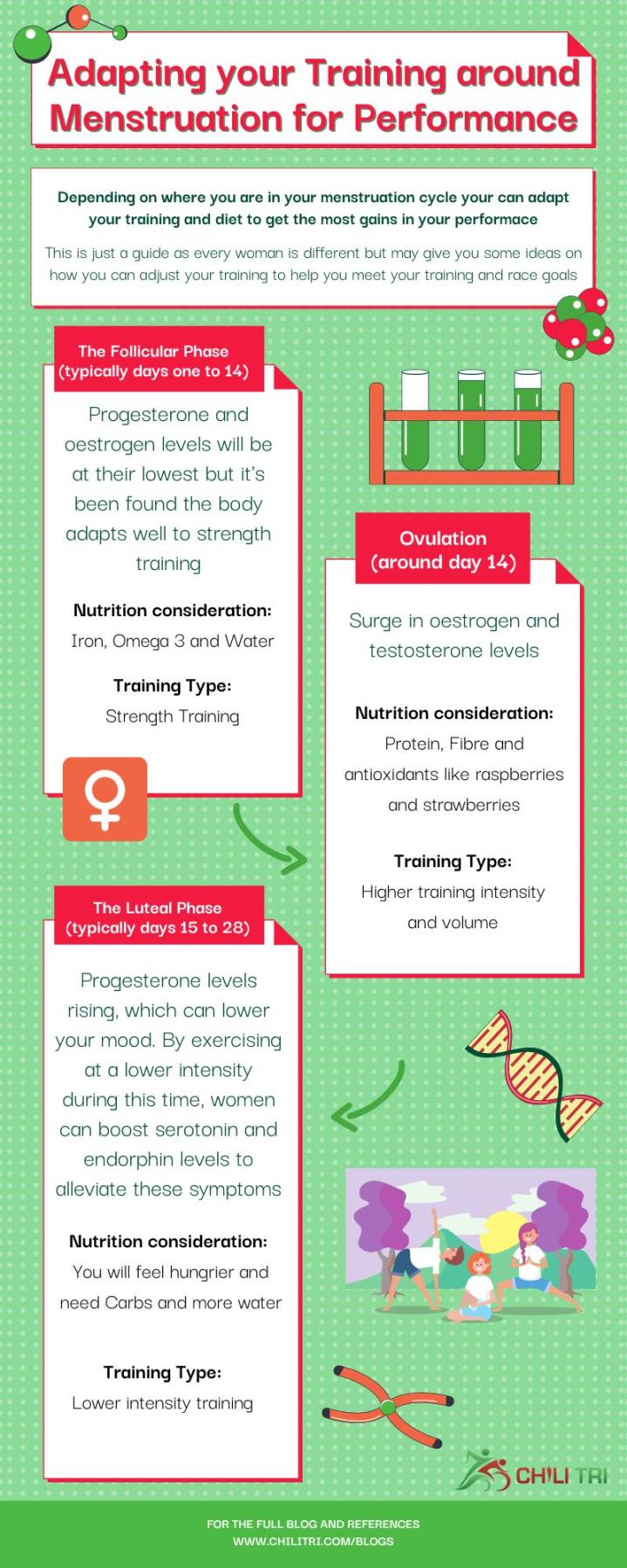
Menstruation and Training Tips Infographic - get in touch if you would like the PDF version
FAQ: How to adapt your triathlon training around menstruation for better performance
How does menstruation affect triathlon training and performance?
Menstruation can impact energy levels, mood, and physical performance due to hormonal fluctuations during the menstrual cycle. Understanding these changes and making adjustments to your training can help optimize performance and reduce the risk of injury or burnout.
How can I adapt my triathlon training around menstruation?
Here are some strategies to consider:
Track your menstrual cycle: Keep a record of your menstrual cycle and note any physical or emotional changes you experience throughout each phase. This can help you identify patterns and plan your training accordingly.
- Plan training intensity: During the follicular phase (the first half of your cycle), when oestrogen levels rise, many women experience increased energy and better endurance. This can be a good time to focus on higher-intensity training sessions.
- Adjust training volume: During the luteal phase (the second half of your cycle), oestrogen and progesterone levels increase, which can lead to fatigue, bloating, and mood changes. It may be beneficial to reduce training volume slightly during this phase or incorporate more recovery sessions.
- Listen to your body: Pay attention to how you feel during your menstrual cycle. If you're experiencing particularly heavy or painful periods, it's okay to modify your training or take a rest day if needed. Prioritize self-care and recovery.
- Nutrition and hydration: Adequate nutrition is crucial during your menstrual cycle. Focus on a balanced diet that includes sufficient iron and other nutrients to support energy levels and overall health. Stay hydrated, especially during heavier flow days.
- Manage discomfort: If you experience discomfort or cramping during your period, consider using appropriate pain relief methods, such as over-the-counter pain medications or heat therapy, to help manage symptoms and allow for more comfortable training.
- Hygiene considerations: Pay attention to hygiene practices during menstruation, especially during open water swimming or long-duration training sessions. Choose appropriate menstrual products and take necessary precautions to maintain comfort and hygiene.
Can I still compete in triathlons during my period?
Yes, many athletes successfully compete in triathlons during their menstrual cycle. It's essential to plan and prepare accordingly. Consider using appropriate menstrual products, such as tampons or menstrual cups, that provide comfort and security during physical activity. Ensure you have access to bathroom facilities and personal hygiene items on race day.
Should I consult a healthcare professional?
If you have specific concerns or experience severe menstrual symptoms that significantly impact your training or performance, it's a good idea to consult a healthcare professional, such as a gynaecologist or sports medicine specialist. They can provide personalized guidance and address any underlying issues that may be affecting your menstrual cycle or athletic performance.
Remember, every individual is different, and what works for one person may not work for another. Pay attention to your body, be flexible with your training, and make adjustments based on your own experiences and needs.
#blog #chilitri #menstruation #triathlonwomen #triathlontraingwomen #menstrualcycle #traithlontrainingplans #runningtrainingplans #swimmingtrainingplans #femalecoach #femaletriathloncoach
